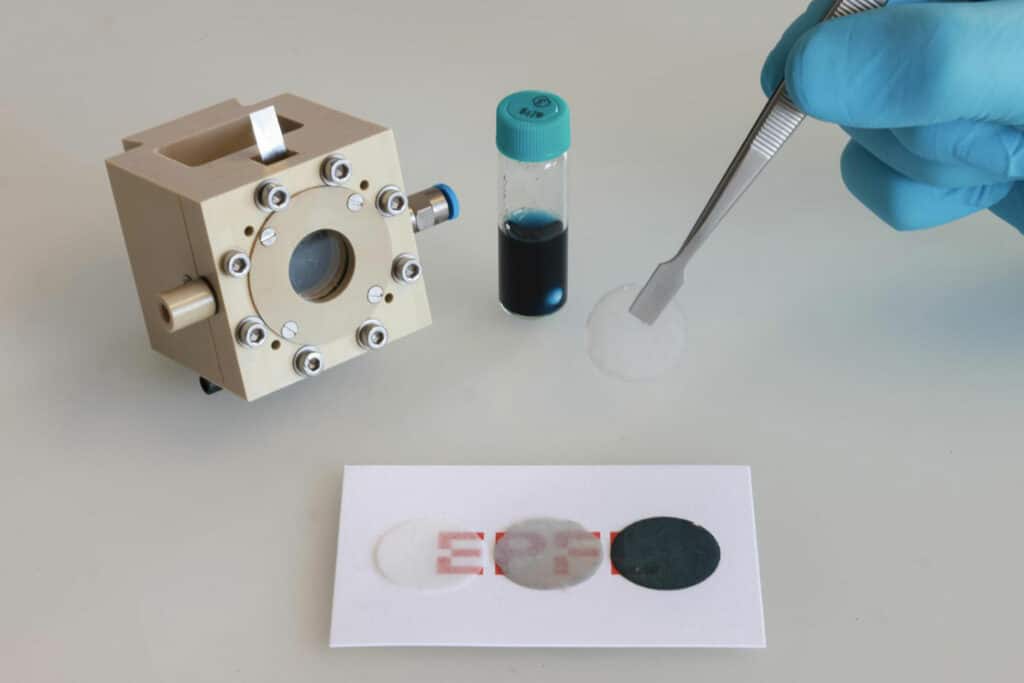A device that can harvest water from the air and provide hydrogen fuel entirely powered by solar energy has been a dream of researchers for decades. The world would go crazy for such a device because who doesn’t want clean fuel for free?
Now, chemical engineers from the Swiss Federal Institute of Technology (EPFL) Lausanne have made a significant step towards bringing this vision closer to reality. They have invented a solar-powered artificial leaf built on a novel electrode that is transparent and porous, capable of harvesting water from the air for conversion into hydrogen fuel.
The ingenious yet simple system that combines semiconductor-based technology with novel electrodes is scalable and easy to prepare. When the small device is simply exposed to sunlight, it takes water from the air and produces hydrogen gas. It’s their novel gas diffusion electrodes, which are transparent, porous, and conductive, enabling this solar-powered technology to turn water – in its gas state from the air – into hydrogen fuel. This can be further used as renewable solar fuel, such as for powering cars or heating homes, researchers say.

To develop the novel system, researchers took inspiration from the way plants are able to convert sunlight into chemical energy using carbon dioxide from the air. During photosynthesis, plant essentially harvests carbon dioxide and water from its environment, and under sunlight, they convert these chemicals into sugars and starches.
In their previous studies, Professor Kevin Sivula and his team have shown that it is possible to perform ‘artificial photosynthesis’ by generating hydrogen fuel using sunlight and liquid water using a device called a photoelectrochemical (PEC) cell. But for practical purposes, it is complicated to make large-area PEC devices that use the liquid.
Researchers wanted to show that the PEC technology can be adapted for harvesting water vapor from the air instead of from liquid water, leading to the development of their new transparent gas diffusion electrode. To make transparent gas diffusion electrodes, the researchers started with a type of glass wool, an insulating material made from glass fiber that has a similar texture to textile wool. The glass wool was processed in a commercial kitchen blender and compressed into felt wafers by fusing the fibers together at high temperatures.
The wafers were then coated with a transparent thin film of fluorine-doped tin oxide, known for its excellent conductivity. These ensured a transparent, porous, and conducting wafer, essential for maximizing contact with the water molecules in the air and letting photons through. Then the wafer was coated again, this time with a thin film of sunlight-absorbing semiconductor materials. This second thin coating still lets light through, even though it appears opaque. As is, this coated wafer can already produce hydrogen fuel once exposed to sunlight.
“Developing our prototype device was challenging since transparent gas-diffusion electrodes have not been previously demonstrated, and we had to develop new procedures for each step,” says Marina Caretti, lead author of the work. “However, since each step is relatively simple and scalable, I think that our approach will open new horizons for a wide range of applications starting from gas diffusion substrates for solar-driven hydrogen production.”
Now, the researchers are focusing their efforts on optimizing the solar-powered artificial leaf technology.
Journal reference:
- Marina Caretti, Elizaveta Mensi, Raluca‐Ana Kessler, Linda Lazouni, Benjamin Goldman, Loï Carbone, Simon Nussbaum, Rebekah A. Wells, Hannah Johnson, Emeline Rideau, Jun‐ho Yum, Kevin Sivula. Transparent Porous Conductive Substrates for Gas‐Phase Photoelectrochemical Hydrogen Production. Advanced Materials, 2023; DOI: 10.1002/adma.202208740
Solar-powered artificial leaf harvests hydrogen fuel from thin air
Source: Tambay News

0 Comments